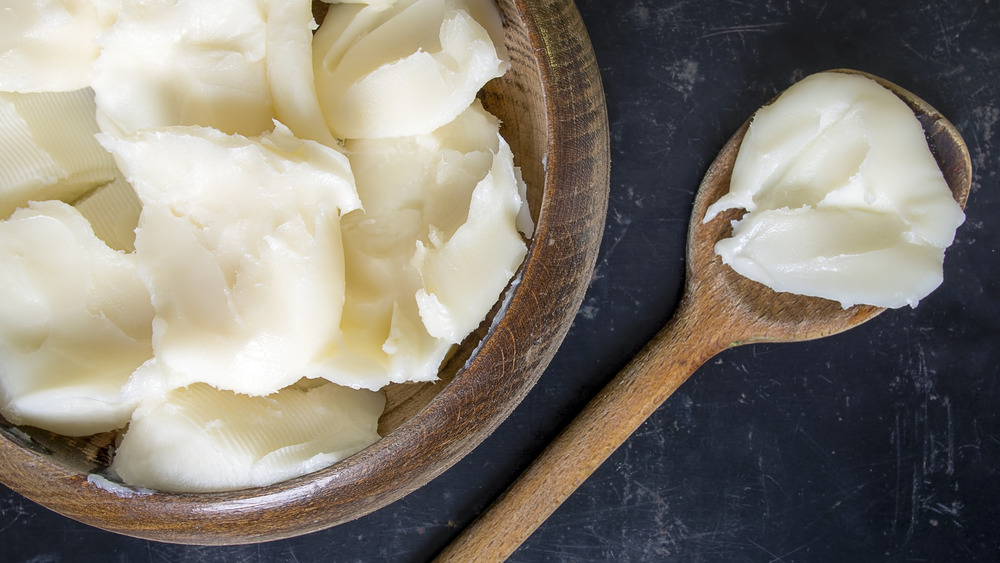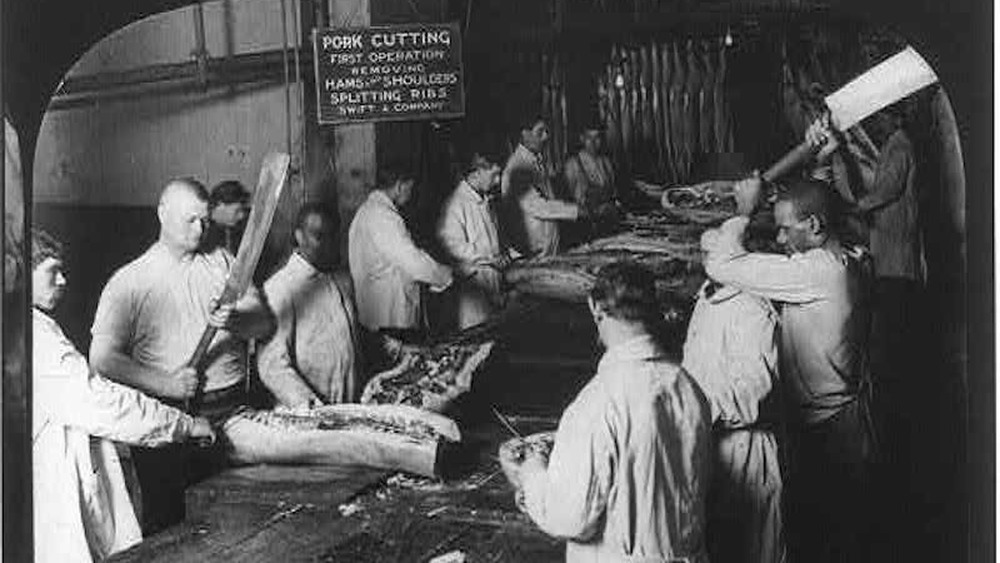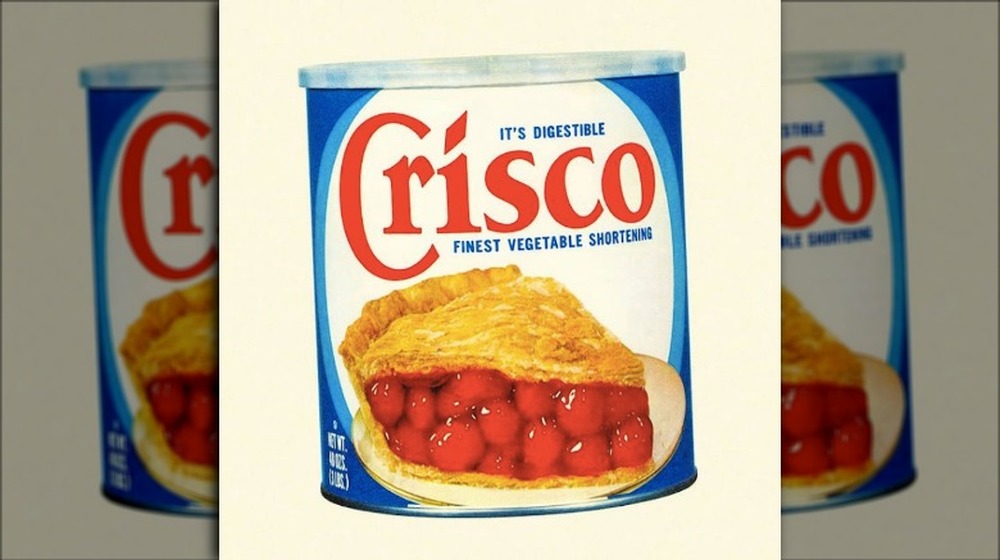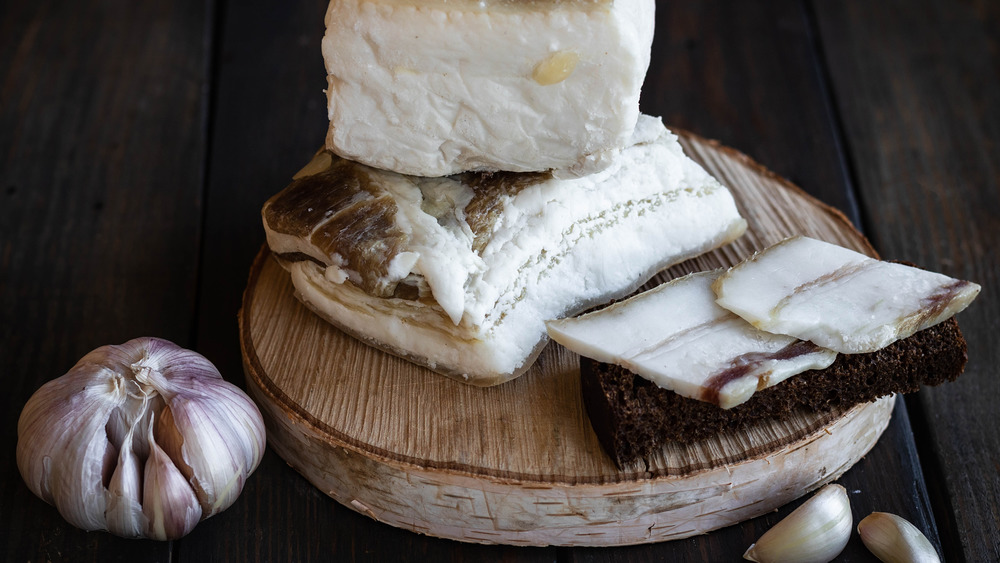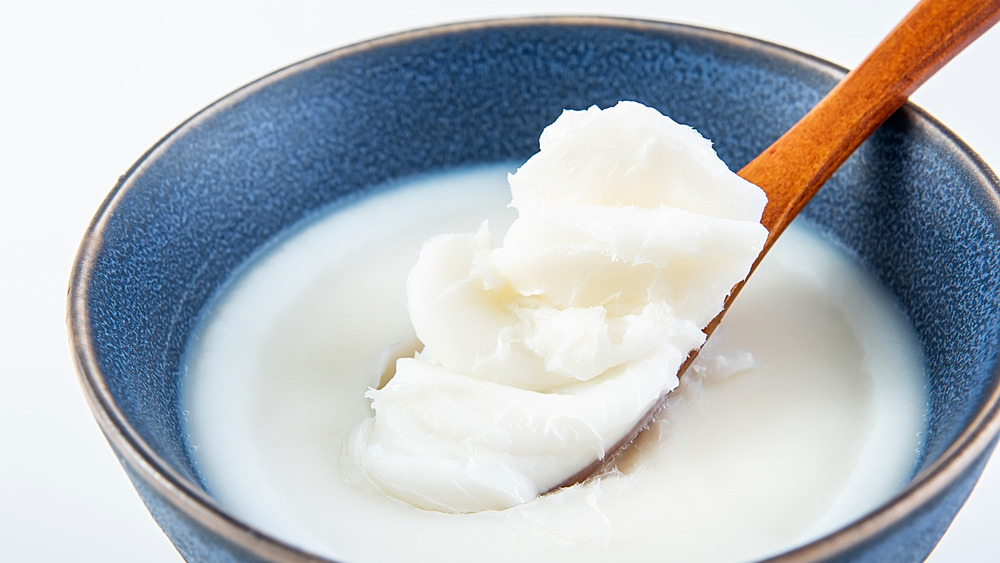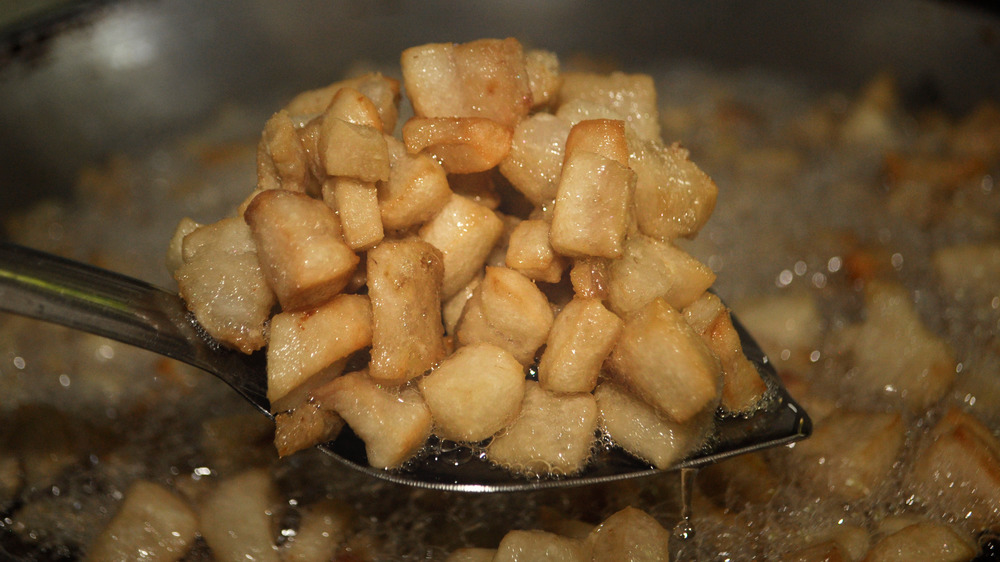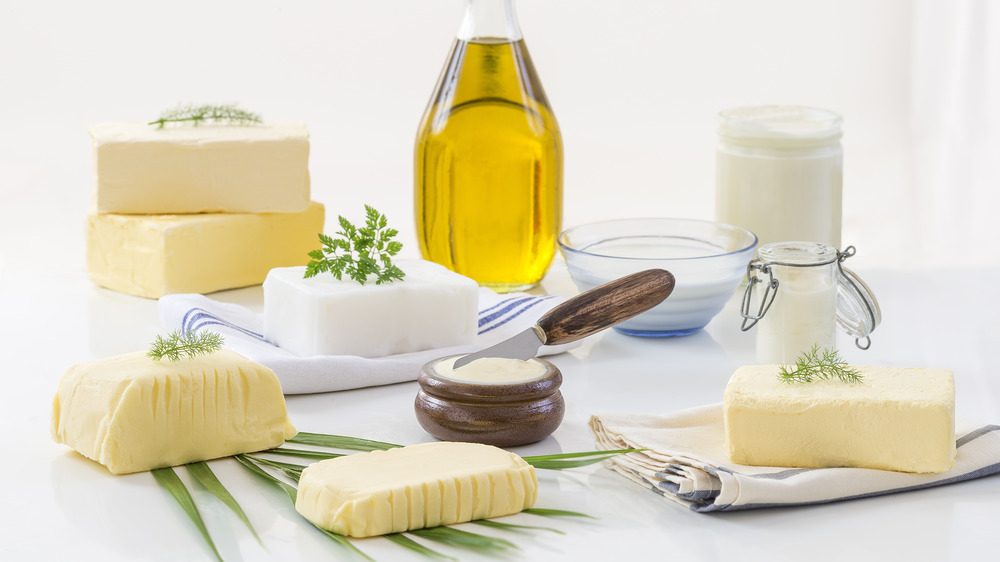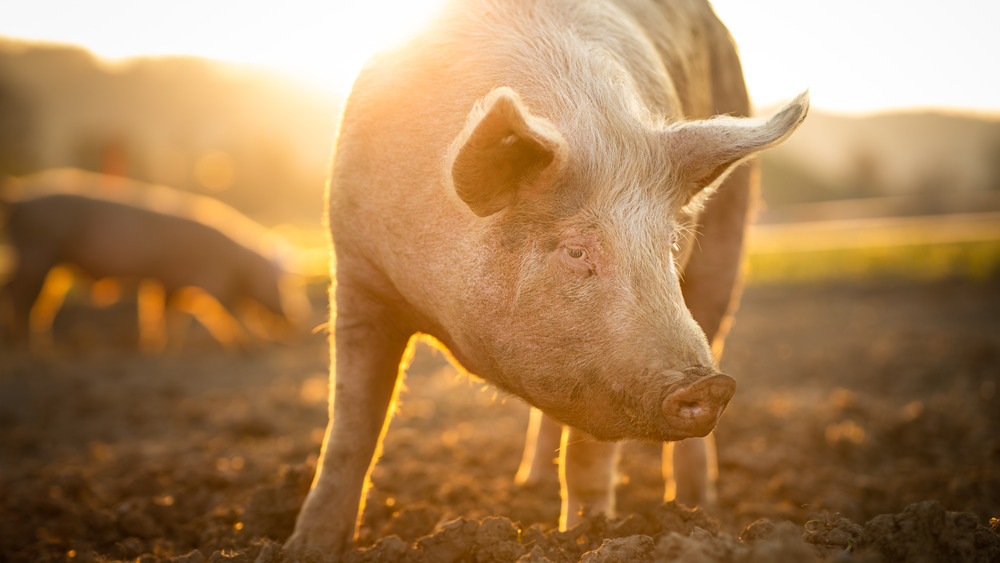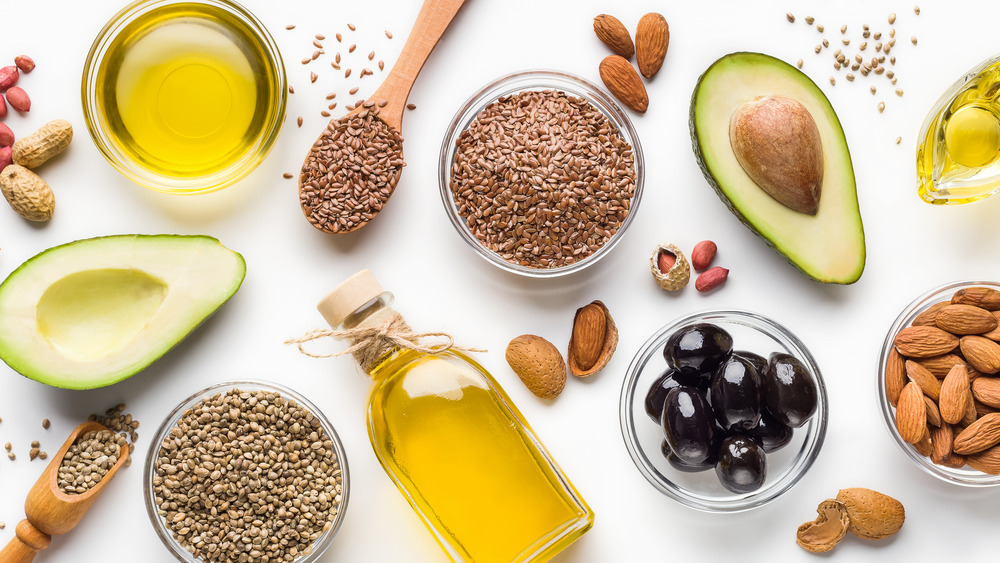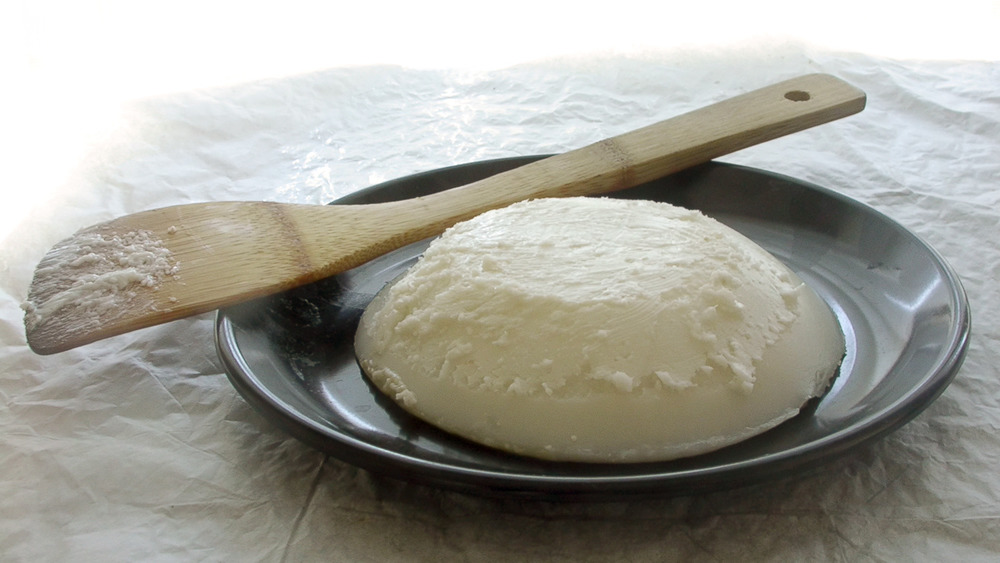The Real Reason Why People Stopped Buying Lard
Fat has a long and sordid history in American food culture, especially in the last century or so. We love it and crave it, as evidenced by the skyrocketing popularity of greasy fast food cuisine. We also hate it with a fervor, as proven by countless diet programs targeting fat, and the rapid growth of the health food industry (via Journal of the History of Medicine and Allied Sciences). And among all the fats out there, there is probably none more contentious than lard.
Rendered from the fattiest parts of a pig, lard was once a mainstay in pretty much every American pantry (via NPR). Fast-forward to today, and it's a safe bet that most of us don't have any lard lying around in our kitchens, nor would we want to. And why is that? How did lard go from being our go-to fat source to essentially a dirty word in the world of healthy cooking (via Slate)? Well, the answer is a little bit complicated — it involves a peek at the history books, as well as a look back at our scientific understanding of fats and health, plus a heaping dose of capitalism. Keep scrolling to find out the real reason people stopped buying lard.
Concerns about lard started with issues in the meatpacking industry
If you're looking for a single person to blame for the fate of lard in American kitchens, look no further than Upton Sinclair. The muckraking journalist of the early 20th century made waves across the country when he published The Jungle in 1906 (via NPR). The novel, a fictional portrayal of immigrant factory workers, was aimed at highlighting poor working conditions among the poorest laborers in the U.S., but more than anything, it served to garner outrage and concern among Americans about the meat industry, and the unsanitary conditions in which their food was being produced for consumption (via New York Times and Constitutional Rights Foundation).
The newfound scrutiny of the meat industry included lard, which was rendered in these factories. It didn't help that there was a particularly grim and gory section in the novel describing the dangerous work of rendering and cooking lard in pig factories. The Jungle wrote this of workers making lard: "their peculiar trouble was that they fell into the vats; and when they were fished out, there was never enough of them left to be worth exhibiting". With that terrifying image in mind, Americans were becoming primed and ready for a new kind of fat to cook with. It wouldn't be long until they got one.
Crisco stole the show from lard
Around the same time that Americans were coming to understand the perils of the meatpacking industry, a growing soap and candle company by the name of Procter & Gamble stumbled upon a technological breakthrough that would completely change the fat game.
At the turn of the 20th century, Procter & Gamble was looking for ways to optimize their soap production, as well as do something with the company's huge supply of cottonseed oil, as the invention of the lightbulb led to a decline in demand for candles (via NPR). Proctor & Gamble invested in a new technology called hydrogenation, which turned cottonseed oil into the pearly, thick substance that we know today as hydrogenated vegetable oil. Proctor & Gamble dubbed it Crisco (via The Atlantic).
This was around 1910, just a few years after the release of The Jungle. As Procter & Gamble was looking for a way to market and sell this new product, the already growing skepticism around meat processing and lard consumption presented a perfect window of opportunity. Plus, during that time, health food claims didn't face the same regulation they do today, so Proctor & Gamble was also able to market their new Crisco product as being healthier than lard. It was an instant hit, and the rest, as they say, is history. Crisco remains a household name to this day (via The Conversation).
The price of lard in the early 20th century didn't help things
On top of safety concerns and the rollout of Crisco, a supposedly healthier alternative to animal fat, the economy was another factor that led to lard's downfall. In the early 20th century leading up to the Second World War, lard became less and less affordable.
In 1929, the stock market crash kicked off the Great Depression in the U.S., and millions of people lost their income. This economic downturn caused prices of food and livestock (including pigs, and thus, lard) to drop drastically across the board as supply piled up (via PBS). In response, the government carried out "emergency livestock reductions" (yep, they killed pigs and cows) in 1933 to help decrease this supply and thus increase prices (via Living History Farm).
A few years later, lard prices were affected again as rationing was imposed in 1943 to support America's efforts in World War II (via The Atlantic). It is also worth noting that government calls for excess lard and other fats to be used to make military weapons during WWII caused many cooks and bakers to turn instead to shortening (and the likes of Crisco) as an alternative, perhaps aiding in the cultural shift away from lard (via Soy Info Center).
Then there were health concerns surrounding lard
By the time the U.S. had recovered from the Great Depression and World War II, a new threat against lard was emerging. This time it was science. NPR reports that in the 1950s, scientists really started raising alarms about the links between lard and heart disease, which was on its way to becoming the leading cause of death among Americans (via NIH). Specifically, researchers warned that saturated fats like lard contain high levels of cholesterol, which was thought to be the main cause of heart disease (via AOCS).
In the last several decades, however, the tables have turned as health experts have come to new understandings about the fat and heart health. Scientists have actually found that the trans fats in vegetable shortening, like Crisco, can cause a range of health issues, including major heart problems (via Healthline). Meanwhile it seems that the saturated fat from animal sources, including butter and lard, is quite not as bad for our health as previously thought. On top of that, science has now shown that there isn't really a link between the cholesterol you eat and heart disease.
The snowball effect of negative public opinion hurt lard
Despite the fact that scientists have updated their thinking on lard, the public has been slower to catch up. By the time new research was published exonerating saturated fats, decades of negative public opinion and a bad reputation among health experts had pushed lard out of most American kitchens (via NPR). And while many are hopeful and pushing for lard to find its way back into our cooking repertoire, it may take a while for the public to see lard in a positive light.
For so long, lard has been thought of as no more than an artery-clogging grease and a derogatory insult (via Slate). For example, on Urban Dictionary, a "tub of lard" is referred to as "a person who is so fat and/or disgusting that the very sight of them invokes images of a giant vat filled with congealed animal fat." That's downright mean, and not just to the lard.
Marketing by the food industry only made things worse for lard
Lard really started to face fierce competition in the market when Crisco hit the shelves in the early 20th century. Procter & Gamble launched an aggressive advertising campaign, propagating the purity of its factory-produced product, and marketing Crisco as healthier and easier to digest than lard (via The Conversation). Regulations on health claims for foods didn't really come around until the late 20th century (via Fooducate).
This paved the way for increased marketing by margarine and vegetable oil companies to push their products as a better fat (via AOCS). Then, as America's "War on Fat" (as Time Magazine puts it) waged on throughout the second half of the 20th century, there was even more urgency to market animal fat alternatives as more heart healthy. The New York Times reported that during this time "an entire industry emerged to create fat substitutes." This mindset spilled across the entire food industry, with the steady rise in low or reduced fat food products, ranging from dairy to desserts, chips and snacks to even leaner meats, all backed by a major industry advertising push to "reinforcing the less-fat-is-good-health message." And the marketing worked ... to the detriment of our health. Of course, all of this was turned on its head amid new scientific breakthroughs around the turn of the 21st century, which would inevitably lead to a whole new set of healthy eating trends (via Vogue).
Safety and environmental concerns about lard remain today
While lard consumption may not carry the same health risks it was once thought to, there are still major health concerns that remain when it comes to pork in general, for both people and the animal. For one, there is still a body of evidence that suggests links between pork consumption and a range of chronic health conditions, including diabetes and cancer (via ZME Science). And in more recent decades, research has shown an increasing percentage of food borne illnesses linked to pork (via Healthline).
Other concerns causing many to turn away from pork include the ethical abuses associated with industrial pig farming and the environmental costs of mass pork production. Even though rendering animal fat in and of itself isn't necessarily harmful to the environment (and can help cut back on waste), high market demand for pig products in general has led to the rise of Concentrated Animal Feeding Operations, which are major sources of toxic pollution and waste (via US News & World Report).
Plus there are all kinds of healthier alternatives to lard
Nowadays, it's easy to see why lard is such an overlooked or outcast fat. Just roam your local grocery store. There is a whole range of fats and oils to choose from on the shelves, from mainstays like butter, margarine, and olive oil to a variety of nut and seed oils that get the job done.
Thanks to our crazed rebellion against all things fat in the latter half of the 20th century, America has seen an explosion in supposedly healthier fat alternatives (via PhillyMag.com) — arguably none more pervasive than olive oil, which has become an American household staple since the 1980s (per Washington Post, New York Times).
Today, the American Heart Association recommends using the following common cooking oils, which they say are better for your health (in alphabetical order, not any sort of ranking): canola, corn, olive, peanut, safflower, soybean, and sunflower.
But lard is definitely making a comeback in kitchens today
As with many come-and-go trends in our diet and food culture, lard is starting to have a full circle moment. The San Francisco Chronicle explained in 2012 that "cooks seeking flavor, farmers advocating a return to more sustainable ways of raising animals and science's shifting thinking on dietary health are all helping to rehabilitate" lard's reputation and place in our food culture.
There is no denying lard has started making a comeback in our kitchens, thanks in part to renewed attention from chefs and foodies. It also helps that newer research has shown that lard may actually be better for your health than butter, containing more good fats and less bad fats than the dairy standard we so often turn to (via The Independent).
These days, the once maligned fat is garnering headlines like this one from The Daily Meal: "5 Reasons Why Lard Is the New Coconut Oil." Lard is being appreciated once again for its "versatility in the kitchen," (per Country Living). It's apparently the secret ingredient your gumbo is missing, as well was your biscuits, and it has a magical ability to create light and flaky pie crusts. And if you are interested in giving this old-school ingredient a try, there is no shortage of lard recipes all over the internet to lend some inspiration.
